Texas Production data show rapid gas
depletion
Oil & Gas Journal, June 21, 1999, Page
61
Some of this work has been updated to 2005 - click
here
PDF copy of the 2001 SPE Paper 70018 that came from this work.
Other Charts and graphs from SPE 70018
Gary S. Swindell, Petroleum Engineering, Dallas,
Texas
Concern over the decline in drilling in the U.S. and falling
production due to plummeting oil and gas prices throughout 1998 and early
1999 has caused new attention to be focused upon depletion rates. Recent
articles have commented on the decrease in U.S. production and the need for
increased drilling in order to sustain reserves and productivity. Studies
1,2 have reported decline rates of more than 45 % in the Louisiana
Gulf of Mexico and higher rates of decline in Kansas. Indeed, the U.S. maintains
a reserve-to-production ratio of only 10.4 years for oil and 9.1 years for
natural gas. But those ratios have been sustained for over 30 years through
new drilling and reserve growth in existing fields (fig. 1). As a result,
an understanding of how that new drilling is performing is important to
forecasting the future of Texas gas production.
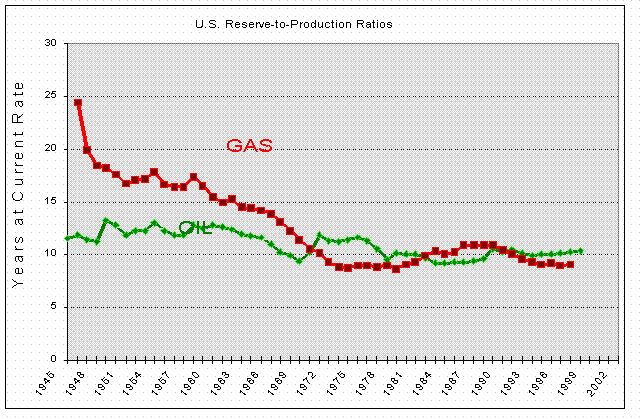
Figure 1 - U.S. Reserve
to Production Ratio
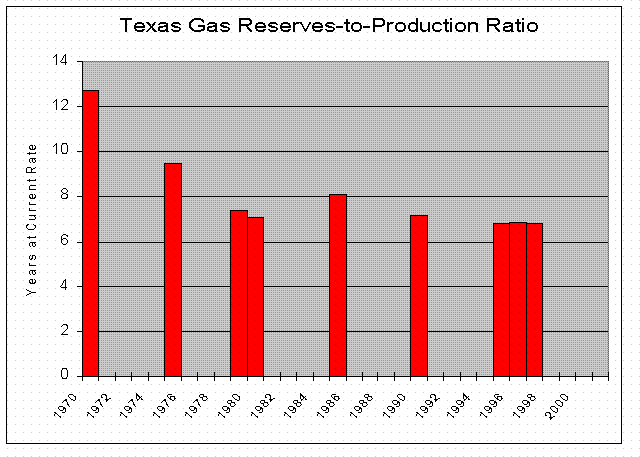
It has been difficult to separate the effect of reserve growth
in existing wells from reserves added through new drilling. The Energy
Information Administration (E.I.A.) gathers reserve reports from some operators,
adds their own work, and extrapolates the data in order to estimate added
reserves. But hard information on the rate of decline from new drilling has
been scarce, a critical factor on the question of how much drilling is necessary
to sustain production rates in the U.S., and one that is not reflected in
the reserve figures.
A study has been made of the depletion rates for natural
gas wells drilled in the State of Texas since 1970 in order to gain an
understanding of how the rates of decline have changed in the last 30 years.
Gas Wells in
Texas
Texas has been the source of 37% of all the natural gas produced
in the U.S. Presently, the state contributes 32% of the daily production,
and holds 26% of the country’s proved gas reserves. In 1997, only the
entire countries of Canada and China exceeded the number of wells drilled
in Texas.

Figure 2 - U.S. natural gas by state
Although Texas natural gas production has been remarkably
constant over the last 30 years (fig. 3), it has been sustained through much
drilling, application of advanced technologies and discovery of new
trends.
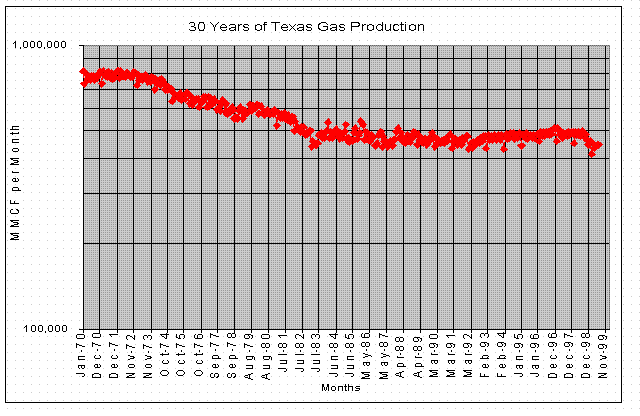
Figure 3 - 30 years of Texas gas production.
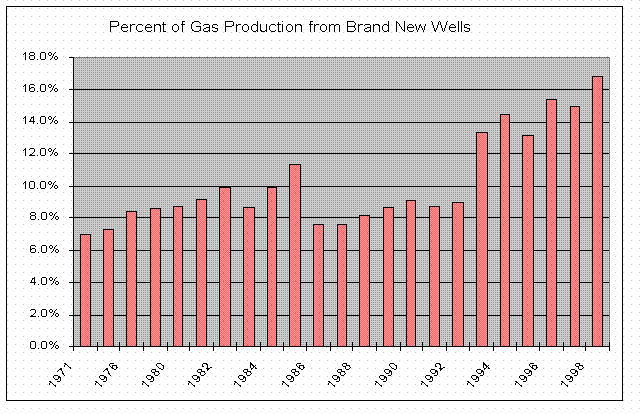
The study consisted of looking at how Texas gas wells drilled
in each year since 1971 performed over time. Wells were grouped by year of
first production, then each “vintaged” group was analyzed for average
initial production rate (usually the 1st complete month of production), decline
rates and average projected reserves. A total of 113,930 gas completions
were put on production during the study period.

Figure 3 - New Texas Gas Completions -
1971-1998
Production from oil wells is reported to the Texas Railroad
Commission on a lease basis rather than by well as is the case with gas.
As such, new infill drilling is often combined with older, existing production,
making it difficult to study the behavior of new wells vs. old. For this
reason, this study was limited to wells classified as gas only.
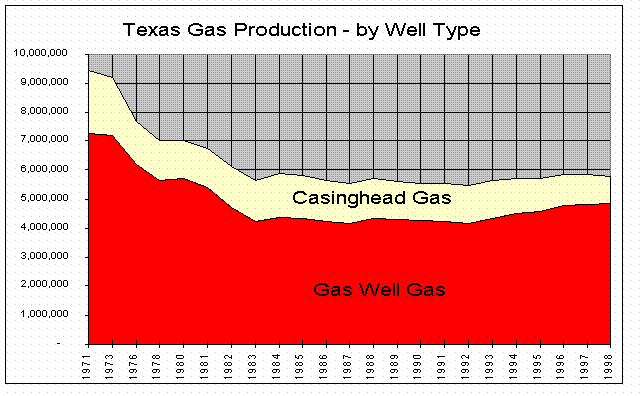
Table 1 summarizes the results of
the study. - Click Here to see table
The number of gas well completions has varied over the years,
generally in accordance with gas prices. The ten year survival rate, or those
wells still active ten years after the initial production, has remained
surprisingly constant during the study period, with a slight improvement
noted in recent years, likely due to the effect of generally higher product
prices.
Initial Production
Rates
Initial production rate showed dramatic changes (Fig 4).
Wells drilled in 1971 averaged 52,324 MCF per month (1,720 MCFPD) in their
first full month. Average initial rates dropped significantly to a low of
15,601 MCF/month in 1983, then began a trend of increases through 1998. Other
individual field studies 4 have shown similar increases. The increases beginning
in 1989 correlate to the acceleration of horizontal drilling in the Austin
Chalk fields of Giddings and Pearsall Fields. Increases prior to that are
likely due to improved, high volume fracturing technology and high productivity
in South Texas drilling.
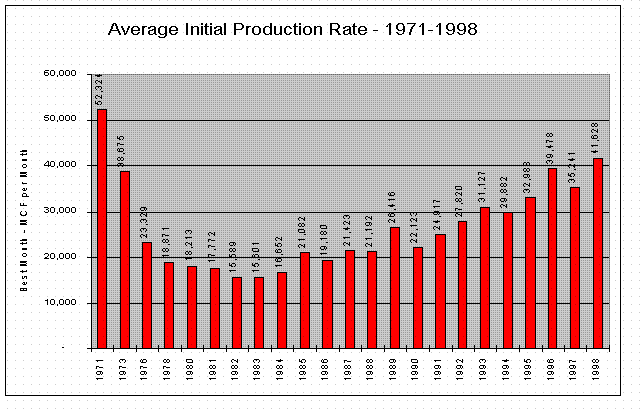
Figure 4 - Initial Production Rates from Texas gas
wells.
Rate of Decline
Although initial rates have actually improved in recent years,
the rates of decline in production have dramatically changed for the worse.
In the 1970’s the first year decline averaged 16% per year, and the
five year overall decline rate averaged about 15% per year. But in the late
1980’s the first year decline rate began a sharp increase to the present
56% per year. Furthermore, the five year average decline also increased to
28% by 1994. Certainly the sharply higher decline rates were due to the influence
of the Austin Chalk horizontal drilling but there were other factors. Bob
West and Bob West North Field in Starr and Zapata Counties (combined they
would have been the 2nd largest gas field in Texas during 1997) was discovered
in the early 1990’s in the Wilcox trend 5. Gas production from those
fields did increase through 1996 but has fallen sharply since, even as drilling
continued. McAllen Ranch (Hidalgo County) and Double A Wells (Polk County)
fields show similar sharp declines in the face of added drilling.

Figure 5 - First year declines of Texas gas
wells
Three selected production decline profiles are shown in Figure
7 for the years of 1971, 1980 and 1996. It is clear that although the initial
well productivity increased from 1980 to 1996, depletion is taking place
at a faster rate and the expected life of the newer wells will be much shorter
than older vintage wells. The newer wells consistently show more hyperbolic
tendencies but with significantly steeper decline rates in the early years.
This pattern is evident throughout each vintage of gas wells.
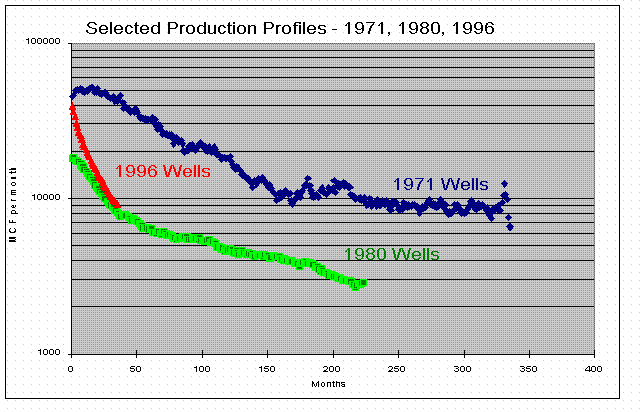
Figure 7 - Selected decline profiles.
Click Here to see individual Year
average profiles
Ultimate Reserves
The average rate-vs.-time plot for each group of vintaged
wells was used to project an ultimate gas recovery, assuming operating costs
of $1,600/well/month, $2.00/mcf gas price and 80% NRI. Average projected
recovery declined from 6,245 MMCF per well in 1971 to 1,019 MMCF per well
in 1998. The trend shows a slow decrease in ultimate gas recovery since 1980.
These figures for Texas wells are in fair agreement with the latest E.I.A.
data which indicate additions from extensions and new discoveries of 15,648
BCF in 1997 as a result of the completion of 10,443 gas wells 3 or an average
addition of 1,500 MMCF per well for the entire U.S.

Figure 8 - Average projected Ultimate Recovery.
Conclusions
There have been substantial changes in the decline profiles
of wells drilled in Texas over the last 30 years. This study indicates that
for new Texas gas wells, the decline rates in the early years are now on
the order of 50% per year. Reserves developed per completion are about 1
BCF per well and show a continuing slow decrease. At those average reserves,
replacement of the state’s annual gas production requires the drilling
of some 6,400 wells compared with 4,048 new gas wells in 1998 (casinghead
gas from oil wells also contributes to gas additions). The sharp early decline
rates suggest that significantly increased drilling will be necessary in
the near future in order to sustain the state’s gas production. A rig
count that remains below the present 200 for the entire state will make it
impossible to support gas production rates in the future. Clearly the industry
will need higher prices if it is going to sustain production with new
drilling.
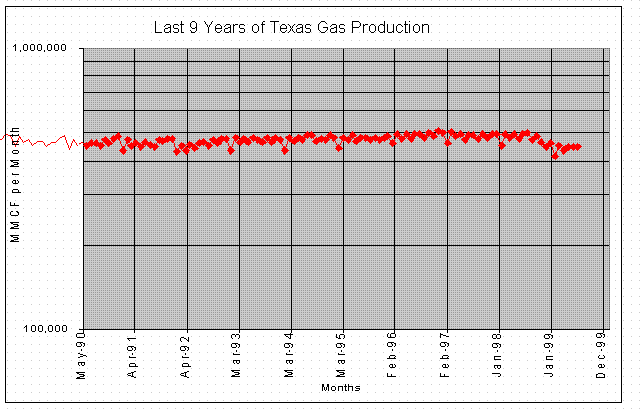
Application of technology, including horizontal drilling,
3-D seismic and advanced fracturing techniques has resulted in significant
increases in average initial gas production rates in the state.
The methodology employed is applicable to other states, but
this study was limited to Texas. Many other states require the reporting
of oil wells on a individual basis rather than a lease basis and in those
states a similar analysis could be developed for oil wells also.
(Production decline plots for major Texas oil and gas fields
and the San Juan Basin are available at http://oil.server4.com. Also available
are the complete set of decline plots for each year studied)
Gary S. Swindell has been an independent reservoir engineering consultant
for 19 years, preparing reserve reports and general reservoir studies for
U.S. and international oil and gas fields. He holds a BS degree in Geological
Engineering from the University of Oklahoma in 1974 and is a registered engineer
in Texas, Oklahoma and Pennsylvania.
Back to -
Gary S. Swindell &
Associates, Dallas
References
1. Simmons, M.R. and Pursell, D.A., Depletion: The Forgotten Factor in Supply
and Demand, Offshore Magazine, Feb., 1999, p 30.
2. Lohrenz, J. and Williams, C.W., “Disaggregated Remaining Reserves
to Annual Production Ratios”, SPE paper 52944, presented at the Hydrocarbon
Economics and Evaluation Symposium, Dallas, March 20-23, 1999.
3. DeGolyer and MacNaughton, Twentieth Century Petroleum Statistics, Dec.
1998.
4. Swindell, G.S., “Reserves and Performance of Canyon Sand Gas Wells
1970-1994”, SPE paper 35204, presented at the Permian Basin Oil &
Gas Recovery Conference, Mar. 27-29, 1996, Midland.
5. Kim, E.M., Further Growth lies ahead for South Texas Wilcox Plays, Oil
& Gas Journal, Mar. 1, 1999, p. 79.











